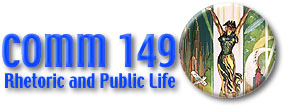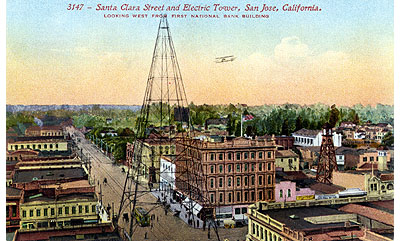
Office: HGH 210; phone: (408) 924-5378
Email: wooda@email.sjsu.edu
Web: http://www.sjsu.edu/faculty/wooda

|
Dr. Andrew Wood Office: HGH 210; phone: (408) 924-5378 Email: wooda@email.sjsu.edu Web: http://www.sjsu.edu/faculty/wooda |
Technology creates efficiency
How does one ensure the smooth integration of home and work, individuality and community, in public life? This question circulates through much of our course. Much of English-Lueck's research indicates that technology serves to blur these apparently contradictory components of public life. English-Lueck quotes a respondent in her research:

How does this occur? One might recall previous conversations about the machine and the garden in which the power to influence human behaviors is hidden beneath subtle environments that seemingly privilege human will. Like the classic Star Trek episode, "Shore Leave," technological means of surveillance and control reside just under the surface of public life and amusement. However, according to many residents of Silicon Valley, even these metaphors are blurred, so that the machine is the garden. Orchards and farmland are rapidly replaced by "campuses" and "office parks." The turn-of-the-century light tower that once straddled Market Street in downtown San Jose [illustrated by the postcard above] would be an anachronism today not because technology has lost its ability to amaze - but because we so thoroughly live in a maze of technology.
Technology integrates relationships
Many respondents to English-Lueck's research also argue that technology - more than city halls or public squares, offers cohesion to contemporary public life:
The question remains: is this a good thing? Langdon Winner warns of the power of ubiquitous technology to create an electronic panopticon, an "all-seeing-place" in which individuals are continually surveyed:
Naturally, many residents and observers of Silicon Valley may disagree. It is possible that computer-mediated relationships create the potential to construct networks of like-minded individuals and groups without the limitations of geography and, with the aid of sophisticated software, even language. Howard Rheingold (1999) proposes that internet communication may indeed enhance the potential for democratic public life. Responding both to recent studies that correlate frequent internet use to social isolation and to Robert Putnam's (1995) influential study of the decline in civic engagement in U.S. society over the past 35 years, Rheingold emphasizes the role of personal and community responsibility in crafting democratic spaces online:
Exploring the role of technology in Silicon Valley - as a tool of efficiency and relationship-building - reveals a fascinating convergence in public life, at least in high-tech communities. Social forces that appear elsewhere to be opposed to one another - leisure and labor, individuality and community - seem to blur in the former "Valley of the Heart's Delight." Shall Silicon Valley continue to pace younger communities seeking high-tech wealth and prosperity? Or, in dystopian contrast, shall it fall prey to warnings made by Joel Garreau and Mike Davis - that public life cannot flourish without physical sites of diversity and democracy?
References